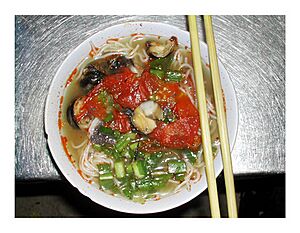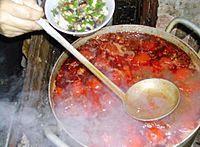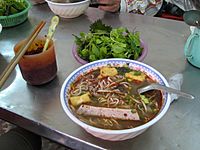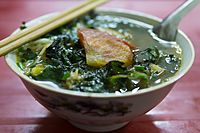Bún ốc facts for kids
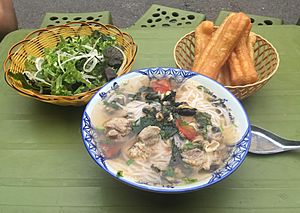
Tomato and snail based noodle soup topped with chopped scallions (added pork ribs)
|
|
| Type | Noodle soup |
|---|---|
| Course | Appetizer |
| Place of origin | Vietnam |
| Region or state | Hanoi |
| Main ingredients | Roasted snails, soup |
Bún ốc is a special Vietnamese noodle soup. Its name means "snail vermicelli soup." This tasty dish comes from Hanoi, the capital city of Vietnam.
The main ingredients are snails and thin rice noodles. Sometimes, people eat roasted or boiled snails as a starter. There are other snail dishes too, like cháo ốc (snail congee) and canh ốc chuối đậu (a thin snail soup with green banana and fried tofu).
Contents
What is Bún ốc?
Bún ốc is a very famous dish in Vietnamese cooking. No one knows exactly when it was first made. Many people think it started in the countryside. Then, it became a popular food in Hanoi.
A similar dish called luosifen is also popular. You can find it in Guangxi, China, which is close to Vietnam.
The Best Ingredients
To make great Bún ốc, cooks choose special ingredients. They often pick smaller, chewy snails. These snails are usually fresh and plump. The rice noodles, called bún, are also important. They should be thin and clear, not soaked for too long.
Besides snails and noodles, Bún ốc can have many other things. These include green bananas, fresh vegetables, chopped water spinach, bean sprouts, and tomatoes.
The Flavorful Broth
The soup's broth is very important. It gets its special taste from "giấm bỗng," which is a Vietnamese vinegar. This vinegar makes the soup a little sour and highlights the flavors. The broth is also made with stewed bones and tomatoes, which give it a slightly sweet taste.
How it's Served
You can enjoy Bún ốc in two main ways:
- Hot snail noodles: The noodles and broth are served together in one bowl. This is a warm and comforting meal.
- Cold snail noodles: The broth is in a separate bowl. You dip the noodles and other ingredients into the broth. This is a popular choice during hot summer days.
Some people like to add shrimp paste and chili to their Bún ốc. This makes the soup even more flavorful and spicy. A famous Vietnamese writer, Vu Bang, once said that Bún ốc is a true "gift" of Hanoi's cooking art.
How Snails are Prepared
Preparing the snails for Bún ốc is very important. Cooks always choose snails that are alive and fresh. You can tell if a snail is alive if its shell is closed tightly. Dead snails often have a bad smell.
Cleaning the Snails
Snails need to be cleaned very well before cooking. Here are some ways to do it:
- Soaking in rice water: Snails are often soaked overnight in water that has rice in it. This helps them release any mud or dirt.
- Brushing the shells: After soaking, the snail shells are scrubbed clean with a brush under running water.
- Using an iron knife: Some people put a small iron knife in the water where snails are soaking. The smell of the iron encourages the snails to clean themselves faster.
- Vinegar or lime juice: Another way is to soak snails in water mixed with vinegar or lime juice and chopped chili. This method is quicker, usually taking 2-3 hours. After this, the snails should be cooked right away to keep them fresh.
Gallery
-
Hanoi-style bún ốc


